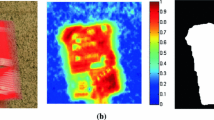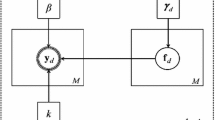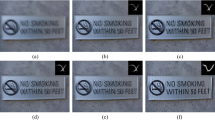Abstract
Blind image deblurring, i.e., reconstructing a sharp version of a blurred image, is generally an ill-posed problem, as both the blur kernel and the sharp image are unknown. To solve such problem, one must use effective image and blur kernel priors. In this paper, a blind image deblurring method is proposed, which uses an effective image prior based on both the first and second order gradients of the image. This prior causes to properly reconstruct salient edges which provide reliable edge information for kernel estimation in the intermediate latent image. This prior along with a hyper-Laplacian kernel prior can be used to solve the optimization problem in the form of maximum-a posteriori-problem, and hence obtaine the blur kernel with a high accuracy. The efficiency of the proposed method is demonstrated by performing several quantitative and qualitative comparisons with the state-of-the-art methods, on both a benchmark image dataset and real-world motion blurred images.











Similar content being viewed by others
References
Cho S, Lee S (2009) Fast motion deblurring. In: ACM Transactions on Graphics (TOG), vol. 28, p. 145, ACM
Cho TS, Paris S, Horn BK, Freeman WT (2011) Blur kernel estimation using the radon transform. In: Computer Vision and Pattern Recognition (CVPR), 2011 IEEE Conference on, p 241–248, IEEE
Fergus R, Singh B, Hertzmann A, Roweis ST, Freeman WT (2006) Removing camera shake from a single photograph. ACM Trans Graph 25(3):787–794
Fortunato HE, Oliveira MM (2014) Fast high-quality non-blind deconvolution using sparse adaptive priors. Vis Comput 30(6–8):661–671
Geman D, Reynolds G (1992) Constrained restoration and the recovery of discontinuities. IEEE Trans Pattern Anal Mach Intell (3):367–383
Geman D, Yang C (1995) Nonlinear image recovery with half-quadratic regularization. IEEE Trans Image Process 4(7):932–946
Javaran TA, Hassanpour H, Abolghasemi V (2016) A noise-immune no-reference metric for estimating blurriness value of an image. Signal Process Image Commun 47:218–228
Javaran TA, Hassanpour H, Abolghasemi V (2017) Local motion deblurring using an effective image prior based on both the first-and second-order gradients. Mach Vis Appl 28(3–4):431–444
Joshi N, Szeliski R, Kriegman DJ (2008) Psf estimation using sharp edge prediction. In: Computer Vision and Pattern Recognition, 2008. CVPR 2008. IEEE Conference on, p 1–8, IEEE
Joshi N, Zitnick CL, Szeliski R, Kriegman DJ (2009) Image deblurring and denoising using color priors. In: Computer Vision and Pattern Recognition, 2009. CVPR 2009. IEEE Conference on, p 1550–1557, IEEE
Krishnan D, Fergus R (2009) Fast image deconvolution using hyper-laplacian priors. In: Advances in Neural Information Processing Systems, p 1033–1041
Krishnan D, Tay T, Fergus R (2011) Blind deconvolution using a normalized sparsity measure. In: Computer Vision and Pattern Recognition (CVPR), 2011 IEEE Conference on, p 233–240, IEEE
Levin A, Fergus R, Durand F, Freeman WT (2007) Deconvolution using natural image priors. Massachusetts Institute of Technology, Computer Science and Artificial Intelligence Laboratory
Levin A, Weiss Y, Durand F, Freeman WT (2009) Understanding and evaluating blind deconvolution algorithms. In: Computer Vision and Pattern Recognition, 2009. CVPR 2009. IEEE Conference on, p 1964–1971, IEEE
Levin A, Weiss Y, Durand F, Freeman WT (2011) Understanding blind deconvolution algorithms. IEEE Trans Pattern Anal Mach Intell 33(12):2354–2367
Liu Q, Sun L, Shao Z (2016) Compound l 0 regularization method for image blind motion deblurring. J Electron Imaging 25(5):053013
Osher S, Rudin LI (1990) Feature-oriented image enhancement using shock filters. SIAM J Numer Anal 27(4):919–940
Pan J, Su Z (2013) Fast-regularized kernel estimation for robust motion deblurring. Signal Process-Image Commu 20(9):841–844
Pan J, Liu R, Su Z, Gu X (2013) Kernel estimation from salient structure for robust motion deblurring. Signal Process Image Commun 28(9):1156–1170
Pan J, Liu R, Su Z, Liu G (2014) Motion blur kernel estimation via salient edges and low rank prior. In: Multimedia and Expo (ICME), 2014 IEEE International Conference on, p 1–6, IEEE
Roth S, Black MJ (2005) Fields of experts: a framework for learning image priors. In: Computer Vision and Pattern Recognition, 2005. CVPR 2005. IEEE Computer Society Conference on, vol. 2, p 860–867, IEEE
Shan Q, Jia J, Agarwala A (2008) High-quality motion deblurring from a single image. In: ACM Transactions on Graphics (TOG), vol. 27, p 73, ACM
Shao W-Z, Li H-B, Elad M (2015) Bi-l 0-l 2-norm regularization for blind motion deblurring. J Vis Commun Image Represent 33:42–59
Sun L, Cho S, Wang J, Hays J (2013) Edge-based blur kernel estimation using patch priors. In: Computational Photography (ICCP), 2013 IEEE International Conference on, p 1–8, IEEE
Wang Y, Yang J, Yin W, Zhang Y (2008) A new alternating minimization algorithm for total variation image reconstruction. IEEE T Image Proces 1(3):248–272
Weiss Y, Freeman WT (2007) What makes a good model of natural images? In: Computer Vision and Pattern Recognition, 2007. CVPR’07. IEEE Conference on, p 1–8, IEEE
Xiong N, Liu RW, Liang M, Wu D, Liu Z, Wu H (2017) Effective alternating direction optimization methods for sparsity-constrained blind image deblurring. Sensors 17(1):174
Xu L, Jia J (2010) Two-phase kernel estimation for robust motion deblurring. Springer, Berlin, pp 157–170
Xu L, Zheng S, Jia J (2013) Unnatural l0 sparse representation for natural image deblurring. In: Proceedings of the IEEE Conference on Computer Vision and Pattern Recognition, p 1107–1114
Author information
Authors and Affiliations
Corresponding author
Additional information
Publisher’s note
Springer Nature remains neutral with regard to jurisdictional claims in published maps and institutional affiliations.
This prior along with a hyper-Laplacian blur kernel prior can be used to solve the optimization problem in the form of maximum-a posteriori-problem, and hence to obtain the blur kernel with a high accuracy.
Rights and permissions
About this article
Cite this article
Javaran, T.A., Hassanpour, H. & Abolghasemi, V. Blind motion image deblurring using an effective blur kernel prior. Multimed Tools Appl 78, 22555–22574 (2019). https://doi.org/10.1007/s11042-019-7402-1
Received:
Revised:
Accepted:
Published:
Issue Date:
DOI: https://doi.org/10.1007/s11042-019-7402-1




